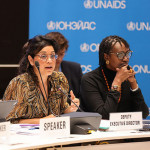What does it mean to be an HIV funder today? And, what does the evolving funding environment mean for the organizations on the front line, those that rely on private philanthropy to continue their work?
These are questions that my organization, Funders Concerned About AIDS (FCAA), will be asking at the 2019 AIDS Philanthropy Summit to be held in Washington, DC, from October 28 to 29.
The Evolving Funding Landscape
A little more than 30 years ago, a group of funders, concerned about the lack of philanthropic leadership in the fight against HIV and AIDS, joined to coordinate their response. Their mission was clear: taking bold actions and engaging in relentless efforts to push philanthropy and — and, in turn, the government — to respond to the epidemic.
Since that time, both public and private funding for the HIV response has grown enormously. As the epidemic took an immense toll, grantmakers were focused on beating it back by directing resources to the scale up of treatment and prevention.
Thus, began an era of “AIDS exceptionalism” — a time when global health decision makers determined that, due to the originally lethal nature of the virus, the disease required a response above and beyond “normal” health interventions. As a result of this approach, there now exists a clear path to ending HIV in our lifetimes. Without that extreme focus and attention, such progress likely never would have occurred.
But now, for both public and private funders, attention is moving elsewhere. At the same time that bilateral and multilateral funding is stagnating, private philanthropic organizations are also shifting focus. In 2017, the most recent period for which data is available, philanthropic HIV-related funding was at its lowest level in three years. It was also concentrated among a small number of funders.
Some grantmakers are eliminating HIV and AIDS from their portfolio entirely. For example, Comic Relief, a top UK-based funder famous for its Red Nose Day events, recently determined that HIV is no longer a priority funding issue.
Other funders are working to center HIV work among the intersectional issues driving the epidemic. Take, for example, the M•A•C Viva Glam Fund, formerly known as the M•A•C AIDS Fund. Throughout its existence, the Fund helped to drive enormous gains. But, as indicated by its recent name change, it is refining its strategy to focus on stigma and inequality. Far from an indication that the HIV/AIDS fight is “over,” this change is intended to double down on the most intransigent obstacles to ending the epidemic.
As another example, The California Wellness Foundation, an organization focused on removing barriers to health tied to a myriad of factors including race and gender, recognized the opportunity to connect its work to HIV. In 2018, it directed $13 million in large part to address the disproportionate impact of HIV on women of color.
So, what is the way forward? Will ending HIV require a new era of exceptionalism? Or, will funders continue to bring the necessary resources to bear in an increasingly intersectional environment?
POZ and the AIDS Philanthropy Summit
FCAA is so pleased to have POZ — particularly in its 25th anniversary year — as the first ever media partner for the AIDS Philanthropy Summit. POZ has long been a friend to our organization, disseminating news of our research on HIV-related philanthropy and other initiatives. Sharing this data with the HIV community, as the publication has done, helps to inform advocacy and grantmaking efforts.
From our perspective, FCAA depends on POZ for its critical news and storytelling, which guides our efforts in shaping and mobilizing the philanthropic response to HIV and AIDS.
POZ reaches the heart of the HIV community — all of you. Through our collaboration on the AIDS Philanthropy Summit, we are hoping to provide an important connection between grantmakers and the organizations they fund. And through this dialogue, we will work to gain clarity around the seeming polarities of AIDS exceptionalism and intersectionality.
But this is a conversation that will be ongoing and must extend well beyond the Philanthropy Summit. We must continue collaborating, shifting, and evolving in parallel to the changing contours of the epidemic itself. Funders and community must be in lock step until the day that we can say that the fight against HIV and AIDS is well and truly over. And we won.
John Barnes is executive director of FCAA, the leading voice on philanthropic resources allocated to the global AIDS epidemic. For nearly 30 years, Barnes has worked in government, nonprofit and corporate settings, and with community-based organizations, to serve people with HIV/AIDS and other critical illnesses.







Comments
Comments